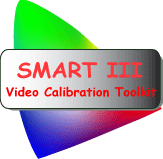SMART III - Video Calibration Toolkit
Steve Smallcombe's SMARTAVTWEAKS site

Black levels and the 11HT
The SONY 11HT handles black level differently from the 10HT and this means
that adjustments concerning black levels must be done differently. Not
only does the 11HT defy the SMART procedure for setting the brightness
and bias, it also defies the Avia process as well. It's not all bad, its
just very different from the way people have been told to adjust brightness
in the past.
The
black level/brightness issue with the 11HT, is that it seems to have active
circuit seeking to restore the black level. With the 10HT the black level
was very stable and depended directly on the brightness and therefore
bias settings. Thus one could use measurement techniques to set these
parameters accurately, e,g as done with SMART II. The 11HT seems to be
actively seeking to restore the black level, regardless of the brightness
setting. Thus standard methods for setting brightness, e.g. VE or Avia,
need to be modified, and the simple SMART II measurement method for setting
bias doesn't work at all.
While
this new "feature" is basically unwelcome, and I still looking
for a way to turn it off, it does have some positive aspects. The basic
idea for setting brightness with the 11HT is that the brightness setting
controls shadow detail or low level gamma tracking, and the black level
will take care of itself. Set brightness too low and the shadow detail
will be lost and turned into black. Set it too high and the overall image
may look too bright or washed out but the blackest levels will still be
near black. As the brightness control is moved over a reasonable range
e.g 40 to 65, the light level at IRE 30 may change by a factor of 2 or
more and the gamma in the low IRE levels from 2 to well above 3. So far
so good - this is a very nice feature with this feature, one could use
SMART to look at the low level gamma tracking and set the brightness to
get a gamma of 2.5.
The
problem is that as the brightness levels is raised, the black level is
not held at the blackest possible level, but comes up as well. Not nearly
as much as the IRE 20 or 30 values, but enough to reduce the contrast
ratio and black levels, and thus to be annoying.
If brightness is adjusted to get the best black level, the gamma is at
3 or higher and this causes an unacceptable loss of shadow detail. At
the brightness settings necessary to get a more acceptable gamma, e.g.
2.5, the black level may come up by 10 or 15 percent - not ideal but not
tragic.
So
it seems at the moment, that one must compromise, to some extent, between
shadow detail and black level. Shadow detail must win this one. I am working
on way of beating this, but for now I simply set brightness so that I
can see IRE 10 window and this gives reasonable gamma tracking at the
low IRE levels. One can also adjust brightness to suit various images
and that is not all bad as the black level staysreasonable during the
process.
The
11HT version of SMART has been thus designed to deal with the bias and
brightess settings appropriately.
Tips
for Tweaking an 11HT
As you get started, the changes to SMART for the 11HT are
1. Don't adjust the bias settings - leave them at the factory low settings
2. Set the brightness at 60 for a IRE 0 or component video source. Do
the calibration run.
3. After the calibration run, add the CC filter. Don't bump the red gain
to 255, leave it where it is. Put the green and blue gains at a similar
level to the red and do another run.
4. Follow the advice until the color balance is restored.
In
the area below the color balance table in Data Entry sheet in the spreadsheet,
you will see advice on adjusting the brightness. If the brightness is
set too low, then the 11HT will tend to have too little light intensity
at low IRE levels, i.e. it will have too high a gamma in this area. An
advice macro analyzes the gamma tracking and may advise raising or lowering
the brightness settings accordingly.
Likewise, gamma tracking for each color is separately analyzed and if adjustment is required, a number will be shown below the appropriate color indicating the number of units the bias for that color needs to be adjusted. If the number is negative, lower the bias by that number of units. The bias adjustments are optional and likely should only be done if a change is indicated that correlates with visual observations, e.g. if the shadows look too blue, and the blue trace is above the other at the low IRE levels, then the advice to lower the blue bias is probably correct.
Introduction to how SMART works
Frequently Asked Questions about SMART
Here is what's new is SMART III version 1.2
The Dummies Guide explains the SMART process in a non-technical way
Buy SMART III at EnhancedHT - your exclusive source for all SMART products
Having trouble? Learn the most common mistakes people make using SMART
Read about using bias lights to improve perceived black levels.
Here are some additional tips for the SONY projectors and solution to common problems.